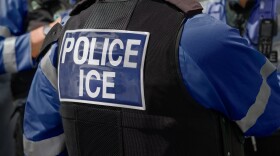Representatives of several churches in the metro Detroit area joined in a march to the U.S. Immigration and Customs Enforcement (ICE) office in Detroit. The event centered around handing a letter to the field office's director, asking for a meeting to reduce the fear and chaos that grips the immigrant community.
“The purpose is to show support for our immigrant brothers and sisters, that we feel that some of the policies and procedures being used now are too disruptive, causing fear and chaos," said David Buersmeyer, a priest in the Catholic Archdiocese of Detroit and chaplain to the “Strangers No Longer” group.

The group is named after a pastoral letter written by Mexican and U.S. Bishops in 2003, calling for immigration reform.
People gathered in front of the Most Holy Trinity Catholic Church in Detroit’s Corktown neighborhood. Most were wearing white. Some were carrying banners identifying their churches, which spanned a number of different denominations and were scattered across several counties.
Some people brought their own signs. Others selected signs from a box provided by the organizing group.
The letter to be delivered to the ICE field director outlined some concerns about how the agency is executing its part in President Donald Trump’s immigration crackdown.
That includes ICE officers wearing facemasks and not showing identification when they pick up people suspected of being in the country without authorization.
The group said ICE is also showing up without warrants signed by a federal judge.
And it said ICE is arresting people who have committed no felony. “Strangers No Longer” says many are legal residents or citizens.

ICE did not respond to questions from Michigan Public. But the agency has said its officers need to conceal their identities because they face threats from the public, and that its arrests and deportations are making the country safer.
Buersmeyer disagrees and said “Strangers No Longer” wants to open a dialog with ICE.
“Because what we could do is we could go back to those immigrant communities to help calm some of the fear if we know some of the ways in which they might be doing things. We want them, though, to be transparent. We want them to be not so disruptive to families. We want them ... to figure ways to do it without causing the kind of fear that’s beginning to arise,” he said.
People were reminded that this was to be a peaceful march, which the Archbishop of the Detroit Diocese, Edward Weisenburger, reinforced in his prayer.
“Father, we ask that you move the hearts of all the members of our great nation, to return to our roots of genuine respect for the human rights of all, and the inherent dignity of each person," he prayed.
As the march began, little was heard except the soft steps on the sidewalks of 350 people carrying banners, signs, Christian symbols, and American flags and a solo drum.
Once gathered in the courtyard of the building where ICE is headquartered in Detroit, a litany of people who were seized by ICE — named and unnamed — was read.

Inside the glass building that houses the field office, some people were videoing the gathering outside and then, to the surprise of those gathered, a couple of them went to the glass and gave the marchers a thumbs-up and made the shape of a heart with their hands. Not all the workers in the building are employed by ICE.
As the marchers started back to the church, I asked a number of people if I could ask them a couple of questions. Some answered in English and some in Spanish, “No.” Some, to me, looked frightened.

One woman was carrying a sign that read “Proud granddaughter of an Immigrant.” She did agree to an interview. It turned out I had interviewed her several years before. Jackie Victor is a successful business person in the Detroit area.
She said her grandfather was a Jewish immigrant and many times she heard the story of how glad he was that he got on the boat that brought him to the U.S.
Several signs noted that the country was built by immigrants.
Back at the church, I asked one of the marshals of the “Strangers No Longer” event, Victoria Kovari, what transpired at the field office between the leaders of the march and ICE. They were hoping for dialog. That didn’t happen.
“They asked if they could deliver the letter inside or if someone could come down to accept the letter so they know who they were giving it to. The officer said, “No,” and shut the door. Dozens of clergy then joined Father Buersmeyer up front to see if we could get someone to acknowledge us and they wouldn’t even open the door,” Kovari said.
When or if the letter is delivered, it asks ICE for an in-person meeting, requesting that happen in the next few weeks.







